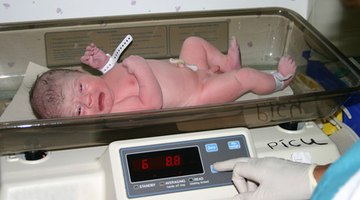How to Calculate an Infant's Caloric Needs
Caloric requirements vary for infants, depending on a variety of factors such as current weight, body composition, birth weight, activity level, medical conditions, age and gender. Parents should watch their infants for satiety and hunger cues, because babies use these cues to show their parents when they are hungry or full, notes the Eunice Kennedy Shriver National Institute of Child Health and Human Development website. Hunger cues include crying and fussing, while satiety cues include falling asleep while eating and spitting out the nipple. Despite the complicated factors involved in determining the true caloric needs of an infant, there is a simple equation to use to get a general idea of how much an infant should consume.
Weigh your infant to determine his weight in pounds.
Convert your infant's weight in pounds to kilograms. There are 2.2 pounds in each kilogram, so you should divide his weight in pounds by 2.2 to determine how much he weighs in kilograms. For example, if your infant weighs 10 pounds, his weight in kilograms is 4.55 kilograms.
Multiply your infant's weight in kilograms by 120 if he is a full-term, healthy newborn. An average full-term newborn needs to consume 120 calories per kilogram of weight each day to grow into a healthy child. For example, if your newborn weighs 4.55 kilograms, multiply 4.55 by 120. The result, 546, is the number of calories your infant should consume in one day.
Tips
Before weighing your infant, remember to zero out the scale. Weigh your infant when she's not wearing any clothes or a diaper to get the most accurate measurement possible.
Warnings
Consult your pediatrician or a registered dietitian before changing your infant's diet because true caloric needs can vary based on a number of factors.











